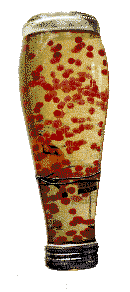Lava lamps are a simple application of
controllable buoyancy. A light bulb heats globs of waxy stuff, the
globs expand with the heat and become less dense than the surrounding
liquid.As they rise away from the bulb, the globs cool and become
more dense than the the liquid, and so they drift back That's not how this gizmo works. The manufacturers neglected to include any globs of low-melting wax, so we had to rely on convection currents within the liquid itself. The little balls of semi-edible colored gum just get carried along as tracers (in fact, that's what first suggested the idea -- usually scientists studying flow have to go to a lot of trouble to introduce tracers into their fluid). So how do you set up a convection flow inside a bottle like this one? (Warning, don't try this at home) First, a heat source: we used a votive candle, available almost anywhere. Second, heat transmission: we started by turning the bottle upside down because a flame could crack the glass and because the thin metal cap is a much better conductor of heat. (The wire stand has been largely retouched out of the pictures). Light the candle, wait, and darn thing actually does what theory says it should. The effect doesn't last all that long, however. The glass is a good insulator, and after 20 minutes or so all the water inside is hot enough that convection doesn't work anymore. More info about the experiment
|
 down. The rest
is just a matter of surface tension and viscosity and immiscibility
and minor stuff like that, which would take a supercomputer some
years to simulate properly.
down. The rest
is just a matter of surface tension and viscosity and immiscibility
and minor stuff like that, which would take a supercomputer some
years to simulate properly.